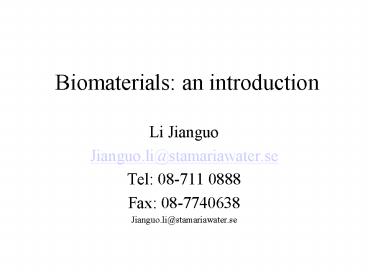Biomaterials: an introduction - PowerPoint PPT Presentation
1 / 32
Title:
Biomaterials: an introduction
Description:
Biomaterials: an introduction Li Jianguo Jianguo.li_at_stamariawater.se Tel: 08-711 0888 Fax: 08-7740638 Jianguo.li_at_stamariawater.se What is a Biomaterial A material ... – PowerPoint PPT presentation
Number of Views:1851
Avg rating:5.0/5.0
Title: Biomaterials: an introduction
1
Biomaterials an introduction
- Li Jianguo
- Jianguo.li_at_stamariawater.se
- Tel 08-711 0888
- Fax 08-7740638
- Jianguo.li_at_stamariawater.se
2
What is a Biomaterial
- A material intented to interface with biological
systems to evaluate, treat, augment or replace
any tissue, organ or function of the body.
3
Biomaterials
- Polymeric biomaterials
- Bioceramics
- Metallic biomaterials
- Biocomposite
- Biologically based (derived) biomaterials
4
Biocompatibility
- Biocompatibility The ability of a material to
perform with an appropriate host response in a
specific application. - Host response the reaction of a living system to
the presence of a material
5
Biocompatibility
- Bf(X1,X2......Xn)
- Where X material, design, application etc.
6
Medical Device
- It does not achieve its principal intended action
in or on the human body by pharmacological,
immunological or metabolic means, but it may be
assisted in its function by such means
7
Polymerization
- Condensation A reaction occurs between two
molecules to form a larger molecule with the
elimination of a smaller molecule. - Addition A reaction occurs between two molecules
to form a larger molecule without the elimination
of a smaller molecule
8
Deterioration of Biomaterials
- Corrossion
- Degradation
- Calcification
- Mechanical loading
- Combined
9
Surface modification (treatment)
- Physical and mechanical treatment
- Chemical treatment
- Biological treatment
10
General Criteria for materials selection
- Mechanical and chemicals properties
- No undersirable biological effects
- carcinogenic, toxic, allergenic or
immunogenic - Possible to process, fabricate and sterilize with
a godd reproducibility - Acceptable cost/benefit ratio
11
Bioceramic Advantages and disadvantage
- High compression strength
- Wear corrosion resistance
- Can be highly polished
- Bioactive/inert
- High modulus (mismatched with bone)
- Low strength in tension
- Low fracture toughness
- Difficult to fabricate
12
Bioceramics
- Alumina
- Zirconia (partially stabilized)
- Silicate glass
- Calcium phosphate (apatite)
- Calcium carbonate
13
Polymeric Biomaterials Adv Disadv
- Easy to make complicated items
- Tailorable physical mechanical properties
- Surface modification
- Immobilize cell etc.
- Biodegradable
- Leachable compounds
- Absorb water proteins etc.
- Surface contamination
- Wear breakdown
- Biodegradation
- Difficult to sterilize
14
Polymeric Biomaterials
- PMMA
- PVC
- PLA/PGA
- PE
- PP
- PA
- PTFE
- PET
- PUR
- Silicones
15
Metallic BiomaterialsAdv Disadv
- High strength
- Fatigue resistance
- Wear resistance
- Easy fabrication
- Easy to sterilize
- Shape memory
- High moduls
- Corrosion
- Metal ion sensitivity and toxicity
- Metallic looking
16
Metallic biomaterials
- Stainless steel (316L)
- Co-Cr alloys
- Ti6Al4V
- Au-Ag-Cu-Pd alloys
- Amalgam (AgSnCuZnHg)
- Ni-Ti
- Titanium
17
Cell/tissue reaction to implant
- Soft tissue
- Hard tissue
- Blood cells
18
The biological milieu
- Atomic scale
- Molecular scale
- Cellular level
- Tissue
- Organ
- System
- Organism
19
pH in humans
- Gastric content 1.0
- Urine 4.5-6.0
- Intracellular 6.8
- Interstitial 7.0
- Blood 7.17-7.35
20
Sequence of local events following implantation
- Injury
- Actute inflammation
- Granulation tissue
- Foreign body reaction
- fibrosis
21
Bioactive materials
- A chemical bonding between bone and material will
be formed
22
Blood material interaction
- Hemolysis
- coagulation
23
Biomaterials applications
- Dental implant
- Tooth fillings
- Vascular implants
- Drug delivery, bone fixing pine, suture
- Bone defect fillings
- Hip joint prosthesis bone plate
- Scaffolds for tissue engineering
- Contanct lens
24
3-principles in dental implant design
- Initial retention
- Anti-rotation mechanics
- No sharp-edges
25
Tooth fillings materials
- Amalgam
- Dental composite
- Ceramics
- Other metals
26
General criteria for tooth filling materials
- Non-irritation to pulp and gingival
- Low systemic toxicity
- Cariostatic
- Bonding to tooth substance without marginal
leakage (20 u) - Not dissolved or erode in saliva
- Mechanical strength, wear resistance, modules
matching. - Good aesthetic properties
- Thermal propertiesy (expansion conductivity)
- Minimal dimensional changes on setting and
adequate working time and radio opacity
27
Textile structure and vascular implant
- Weaving
- Braiding
- knitting
28
Calcium phosphate-based bioceramic
- Bone (ACP, DCPD, OCP HA)
- Ca-P compounds
- Applications
- Bone fillers/HA-coatings/HA-PLA/In situ
setting cement/tooth paste/drug tablets
29
Hip joint prosthesis
- Ceramic head
- Metallic stem
- Polymeric socket
- Composite bone cement
30
Standards
- Test methods
- Materials standards
- Device standards
- Procedure standards
31
Testing of Biomaterials
- Physical and mechanical
- Biological
- In vitro assessment
- in vivo assessment
- Functional assessment
- Clincal assessment
32
Requirements for Soft Tissue Adhesive
- Biodegradable
- Fast spread on wet (wound) surface
- Adequate working time
- Adequate bonding strength
- Hemostasis
- Biocompatible























![Global Orthopedic Biomaterials Market: Opportunities,Segmentation and Forecast [2015-2021] PowerPoint PPT Presentation](https://s3.amazonaws.com/images.powershow.com/8310465.th0.jpg?_=20190407120)







